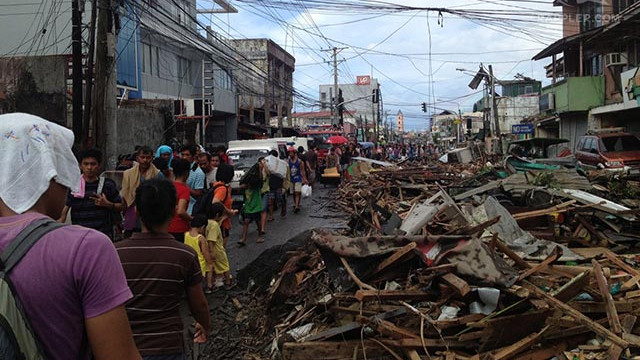SUMMARY
This is AI generated summarization, which may have errors. For context, always refer to the full article.

GENEVA, Switzerland – Disasters caused global economic losses of about US $130 billion (94.5 billion euros) in 2013, Swiss Re said on Wednesday, December 18, but there was little insurance coverage for the deadliest catastrophe, Typhoon Yolanda (Haiyan) in the Philippines.
In a preliminary estimate of the impact of natural and man-made disasters, the Zurich-based reinsurance group noted that the economic impact was sharply down from US $196 billion in 2012, a year marked by Superstorm Sandy in the United States.
But the total loss of life climbed to about 25,000 people from 14,000 in 2012, it said.
November 2013’s Typhoon Haiyan in the Philippines was the deadliest single disaster, killing more than 7,000 people, Swiss Re noted.
But despite the devastation wreaked, insured losses from the typhoon are expected to be modest, it said.
It pointed to the low proportion of insurance coverage in the Philippines – a common issue in developing nations, which are also among the globe’s most disaster-prone countries.
Swiss Re did not release an estimate for the Philippines, but insurance- and disaster-risk modellers AIR Worldwide recently put the economic losses at US $6.5-14.5 billion and insurance coverage at US $300-700 million.
The latter figure accounted only for physical damage to insured buildings and their contents, and did not include such areas as losses of crops or business interruption, AIR Worldwide noted.
“In many parts of the world, insurance penetration remains low,” Swiss Re’s chief economic Kurt Karl said in a statement.
“Together with preventative measures, insurance can lessen the destructive impact and financial burden that large catastrophic events can have on people’s lives. It can also help accelerate reconstruction efforts, as we have seen in areas where insurance penetration is higher,” he added.
The insurance industry is likely to cover about US $44 billion of the 2013 disaster losses, Swiss Re said.
It noted that the figure was substantially lower than the US $81 billion in payouts in 2012, largely down to Superstorm Sandy.
The costliest single disaster of 2013, both in terms of losses and likely insurance payouts, was the flooding in June that battered Germany, the Czech Republic and neighboring countries in central Europe.
The floods, which claimed two dozen lives, caused economic losses of around US $18 billion, with Us $4.0 billion of that insured, Swiss Re said.
Insured losses were nonetheless higher than during the 2002 floods in the same region, which cost the industry US $3.0 billion at current prices.
The June 2013 disaster ranked as the second most expensive fresh-water flood on record, but still lies a distant second to the 2011 Thailand floods which led to insured claims of over US $16 billion, Swiss Re underlined.
Europe was also hit by Hailstorm Andreas in Germany and France in July, with insured losses of US $3 billion.
The more recent Windstorm Christian and Windstorm Xavier in central and northern Europe triggered insured losses of around US $1 billion each.
June rains and flooding in the Canadian province of Alberta led to insured losses of US $2.0 billion, the highest ever recorded in the country for any disaster.
There were also heavy rains and floods in Australia, India, China, Indonesia, Southern Africa and Argentina in 2013.
Harsh spring and autumn weather caused severe thunderstorms and deadly tornadoes in the United States, but the 2013 North Atlantic hurricane season was benign, Swiss Re noted.
The company is set to release its definitive 2013 disaster data in March 2014. – Rappler.com
Add a comment
How does this make you feel?
There are no comments yet. Add your comment to start the conversation.